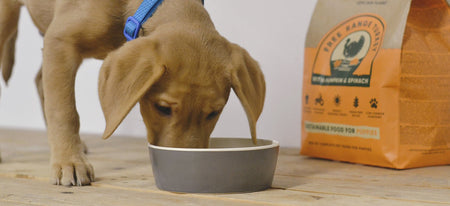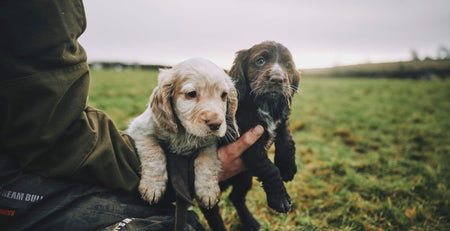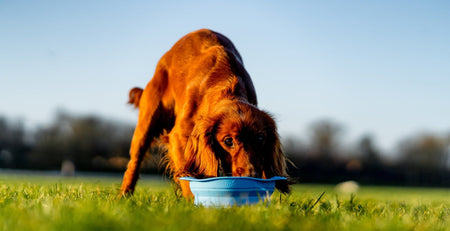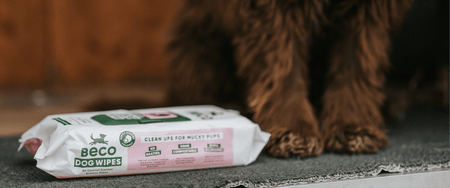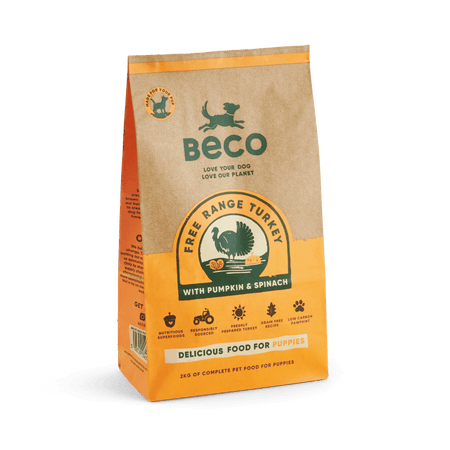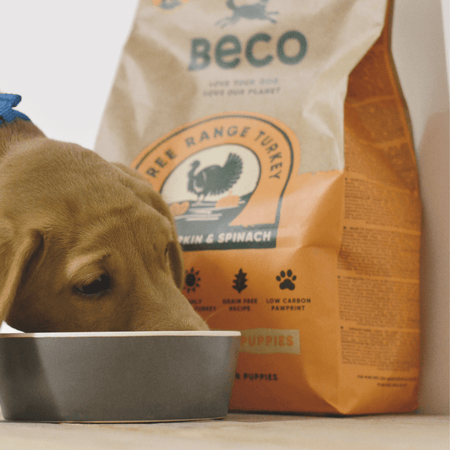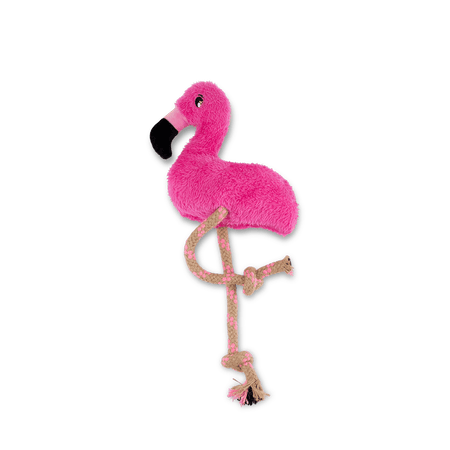Bringing a new puppy home? Exciting times! But let's face it, figuring out their feeding schedule can be overwhelming.
How much is too much? Are they getting enough nutrients?
Don't worry, we've got you covered.
From portion sizes to meal frequencies, we'll break down everything you need to know about feeding your furry friend. Get ready to raise a happy, healthy pup with this no-nonsense guide to puppy nutrition.
How Much to Feed a Puppy by Weight (kg)
The easiest way to make sure your dog is getting the right amount of food for their weight is to measure the food on your scales at home.
The guide to how much you should be feeding your dog throughout their life should be on the back of your dog food packets or on the brand websites.
The guide below is the feeding guide for our puppy food. Keep in mind that, ultimately, as with humans, every dog is different. Many state that 20g for every 1kg is appropriate when deciding how much you should feed your puppy. However, it actually depends on the type of food and the type of dog.

Am I Feeding My Puppy Enough?
It’s sometimes tricky to tell if your pup is under-eating or over-eating but the quickest way to determine this is by scanning their body condition.
As a rule of thumb, you should be able to feel but not see their ribs and their waist should be visible when you look down at them.
Body condition, not the amount eaten or left in the bowl, should determine portion sizes. Portion sizes depend on individual metabolism and body type, and nutritional needs vary from dog to dog.
If your puppy occasionally skips a meal or picks at food, don’t worry. This could simply mean they’re ready to eliminate a feeding. You could also be feeding your pup too much. This is why it’s important to weigh your puppy regularly.
How Often Should I Feed My Puppy?


Puppies grow and develop rapidly, so their feeding schedules need to adjust as they age. Like human babies, pups initially need many small meals daily with food formulated for their specific life stage.
Here is a brief breakdown of ages and meal times:
8-12 Weeks
Feed four times a day, as a young puppy’s stomach is small. Frequent feeding helps with nutrient absorption without overloading the digestive system.
3-6 Months
Consider cutting food to three times a day, as they still need regular meals to support high energy levels and rapid growth.
6-12 Months
Most puppies are ready for two meals a day, a schedule that often continues into adulthood. Larger breeds may need this feeding pattern until 18-24 months due to extended growth periods.
Spayed or neutered dogs need less energy, so it could be a good time to switch from nutrient-rich puppy food to adult maintenance food.
Always consult your vet before changing from puppy to adult food . If in doubt, stick to puppy food rather than switch too early to ensure all the necessary nutrients for proper growth and development.
12 Months and Older
Small breed dogs reach adulthood at around 12 months and large breeds at about 24 months. You can now feed them twice a day to maintain steady energy levels and overall health.
If you’re training with treats, keep them as small as possible and adjust the weighted amount of your puppy's meals to ensure you’re not overfeeding.
Essential Nutrients for Puppies
Puppies need a balanced, nutrient-rich diet to support growth and development. Aim for high-quality food that meets the nutritional standards for growth and reproduction.
Ingredients for a Health Diet
Protein and Amino Acids: Vital for the growth and repair of tissues and muscle. Look for high-quality protein sources like chicken, beef, lamb, and fish.
Fats: Provide energy and help in the absorption of fat-soluble vitamins. Essential fatty acids like Omega-3 and Omega-6 enhance skin and coat health as well as aid brain development.
Carbohydrates: An important source of energy. Whole grains, vegetables and fruits provide your pup with the necessary fibre and enzymes.
Vitamins and Minerals: For overall health, including calcium and phosphorus for strong bones and teeth, and vitamins A, D, E, and K for various bodily functions.
Glucosamine and Chondroitin: For joint support.
Water: Important for any age of dog but especially for growing puppies.
These nutrients, along with others, support overall wellness, including digestion, skin and coat health, and immune function. By choosing a specifically formulated food, you won’t be left wondering if you’re feeding your puppy enough while creating an excellent nutritional foundation.
Don’t Forget To:
Read the Label: Choose a puppy food that lists a high-quality source of protein as the first ingredient. Avoid foods with fillers like corn, wheat, and soy.
- Consider Breed-Specific Formulas: Some brands offer breed-specific formulas tailored to unique needs, such as large, small or senior dogs.
Common Challenges in Feeding Puppies
It might sound easy, but feeding a puppy isn’t always straightforward. Here are some common challenges and tips on how to overcome them:
1. Switching Foods
To avoid digestive issues, you should gradually change your puppy's food over a 4-week period. This allows their system to adapt to a new diet and you can monitor for adverse reactions like diarrhoea or vomiting.
A slow transition is particularly beneficial for fussy eaters, giving them time to adjust to new flavours without abruptly removing their familiar food. Follow this 4-week transition plan:
Week 1: 25% new food, 75% old food
Week 2: 50% new food, 50% old food
Week 3: 75% new food, 25% old food
Week 4: 100% new food
You can mix the foods or place them in different bowls - it's completely up to you.
By following this method, you minimise the risk of digestive upset and increase the chance of your pup accepting new food.
2. Dealing with Picky Eaters
Some puppies are picky eaters. Try tantalising their tastebuds by warming food slightly to enhance the aroma or mixing a bit of wet food into dry kibble. You can also add a small amount of chicken broth to their food.
3. Hydration
If you suspect your puppy isn’t drinking enough water, try adding water to their food or offering them ice cubes to lick. Always have a fresh bowl of water out that’s easy for your pup to access.
4. Overfeeding & Underfeeding
It’s tempting to give your puppy extra treats or larger portions, but overfeeding could cause obesity and other health problems. On the other hand, underfeeding leaves pups malnourished or stunted in their growth.
Consult your vet if you’re unsure and regularly monitor your puppy’s weight.
To discourage picky habits, feed at regular times in regular amounts and do not leave food down for more than 10 to 20 minutes.
Wet vs. Dry Food
Both wet and dry foods have their advantages. Wet food can be more palatable and easier for puppies to eat. Dry food is often more convenient and helps keep their teeth clean. A combination of both provides balanced nutrition and variety.
Should I feed my puppy wet or dry food?
When your puppy arrives home with you at 8 weeks or older, they should have transitioned to a solid diet.
Although there’s no scientific consensus on whether dry is better than wet food for puppies, there are a few things to consider when deciding which to feed your pup.
Wet food can have a slightly stronger smell and be messier.
Dry food is convenient and you can use it for treats during training.
Some fussy eaters find switching from wet to dry food difficult and vice versa.
Puppies who are teething and have sensitive gums may find dry food uncomfortable to eat. (You can moisten biscuits with water if needed.)
Treats and Supplements
Treats and supplements both have a place in raising your pup, but you should consider certain factors.
Treats: A Tool for Training and Bonding
Treats are an excellent way to train and reward your puppy but moderation is key. When choosing treats:
Opt for healthy, low-calorie options.
Avoid treats with artificial additives,
Ensure treats don't exceed 10% of your puppy's daily calorie intake.
Remember, treats are not just for rewards; they're also a fantastic bonding tool. Use them wisely to strengthen your relationship with your new furry friend.
Avoiding Dangerous Treats
Puppies are curious creatures and, like babies, tend to explore the world with their mouths. This curiosity can sometimes lead to trouble.
To keep your puppy safe:
Be vigilant about what your pup can access. Socks, small toys, and other household items can be tempting but dangerous if swallowed.
Avoid giving treats that could cause blockages, such as pigs' ears, hooves, and bones. These items can obstruct the gastrointestinal system in both puppies and adult dogs.
Contact your vet immediately if you suspect your puppy has swallowed something they shouldn't have. They may need to induce vomiting, use an endoscope, or, in severe cases, perform surgery.
Check your pet insurance policy. Many don't cover incidents until a certain period after the policy starts. Always research or consult your provider before bringing your puppy home.
Supplements: Proceed with Caution
While supplements can be beneficial, they should be used judiciously. Always consult your vet before adding any supplements to your puppy's diet. They'll help you determine if supplements are necessary and safe for your pup.
If your puppy has health issues, their nutritional needs may differ. Always consult your vet to determine the best diet for your puppy's needs.
Should I Feed My Begging Puppy More?

If you’re wondering how much kibble you should feed your dog, remember puppies beg for various reasons.
The first is behavioural. Dogs are intelligent creatures, and their endearing "puppy eyes" can often persuade even the most resolute owners to give in to their demands. This is especially true when it comes to food.
Here are some tips to prevent begging:
Feed your puppy at regular times. Puppies thrive on routines.
Place your puppy in their crate, bed, or a different room when you're eating. Avoiding temptation might be best for some.
Don’t be tempted to feed your puppy from the table or out of your hand when indoors, including when cooking. Any snacks should come from their bowl.
Offer snacks at different times from your meals to avoid the association between your eating and the puppy getting food.
By feeding treats from their bowl, puppies learn where to find food and are less likely to look for it at the table or on countertops.
If you think your puppy is still hungry after eating, consider reweighing them to ensure they're receiving the right amount of food for their weight and age.
Keep in mind that many factors, from parasites to medical conditions, can suddenly affect your puppy's appetite. If you're concerned, please consult your veterinarian.
Frequently Asked Questions
Can I give my puppy homemade treats?
Yes, you can give your puppy homemade treats, but it’s important to ensure they are made from safe, dog-friendly ingredients. Some suitable options include using dog food, fruits like blueberries and apples, or vegetables like carrots and cucumbers.
What should I do if my puppy has food allergies?
If you suspect your puppy has food allergies, consult your vet for a diagnosis. They may recommend an elimination diet to identify the allergen or switching to hypoallergenic food with novel proteins and limited ingredients. Avoid common allergens like beef, dairy, wheat, chicken, and soy.
Conclusion
Feeding your puppy doesn't have to be complicated. With the right knowledge and a bit of patience, you'll be a pro in no time.
Remember, every pup is unique, so don't be afraid to adjust as needed. Keep an eye on their body condition, stick to a consistent schedule, and choose high-quality ingredients. Your furry friend will thank you with boundless energy and a wagging tail.
Ready to give your pup the best start in life? Browse our delicious range of grain-free puppy food today.

